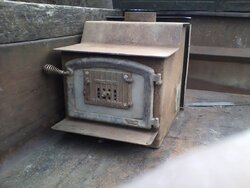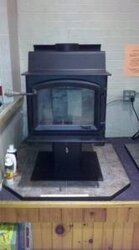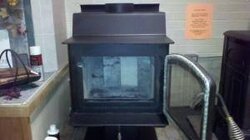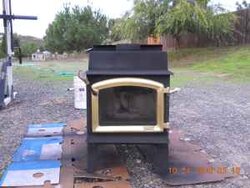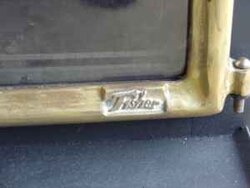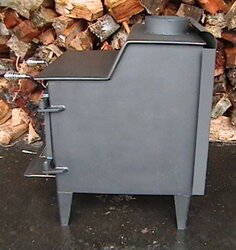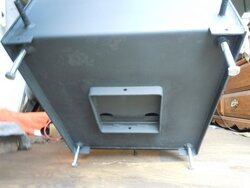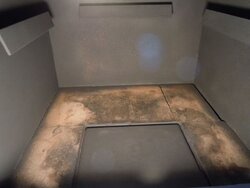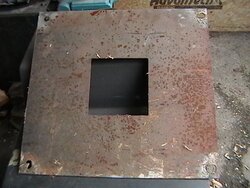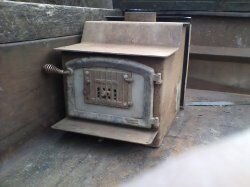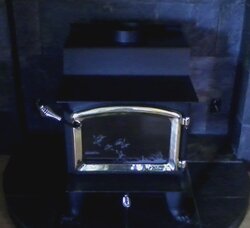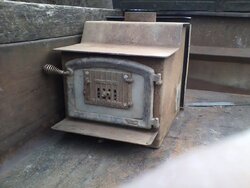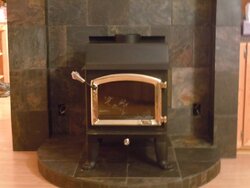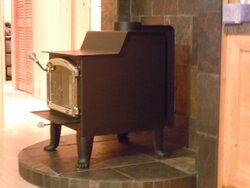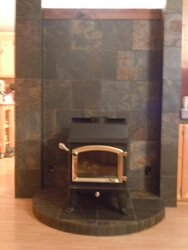Found this Fisher and don't really know what type it is. Wondering if you could help me out? It is missing the original legs and the glass has been replaced with a modified warm morning door as you can see. Has the draft control in the center on the very bottom too. Don't know if it had fire brick or not? Is it a rare find or worth much and can you find some original legs somewhere or know the length of them, they screw I think.
Someone help identify this FISHER
- Thread starter mtn man
- Start date
-
Active since 1995, Hearth.com is THE place on the internet for free information and advice about wood stoves, pellet stoves and other energy saving equipment.
We strive to provide opinions, articles, discussions and history related to Hearth Products and in a more general sense, energy issues.
We promote the EFFICIENT, RESPONSIBLE, CLEAN and SAFE use of all fuels, whether renewable or fossil.
You are using an out of date browser. It may not display this or other websites correctly.
You should upgrade or use an alternative browser.
You should upgrade or use an alternative browser.
- Status
- Not open for further replies.
wooddope
Burning Hunk
It doesn't appear to be a fisher. From what I can make out from the lettering on the door it is a warm morning model.
The door frame is definately a fisher, that thing that says warm morning on it is what someone has added to the unit.
pen
pen
Stephen in SoKY
Feeling the Heat
Late Honey Bear?? If 20" wide. Need the size. Tag readable? The rear shield wraps around like a Grandma, but Honey Bears shields are like that too. (side view of double door shown below from Enduron Corp.) Pedestal cut off or missing legs, like this?
The leg length in that picture gives you an idea how long to make them.
Similar to the Fisher Blenheim legs still in production.
The leg length in that picture gives you an idea how long to make them.
Similar to the Fisher Blenheim legs still in production.
Attachments
valley ranch
Feeling the Heat
That's a nice find! You see how good coaly's stove looks in the pictures. I'ed put glass in the door and be very happy with it.
Here you go mtn man, I resized your pictures for you ;
Yes folks, this is the same stove as shown in the first post in the truck bed !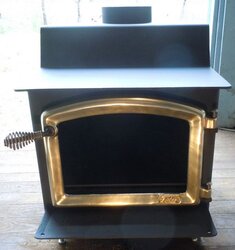
The bottom air intake is due to an available mobile home outside air kit.
The spring handle needs to be unscrewed about half the handle. With a rag wrapped around the spring end (the end all the way dowm the shaft) grip the last turn of the spring and turn clockwise to unscrew it up the handle rod. This will open the spring and allow it to wind up the handle. If loose, you can normally crush it down to fit the rod tight, and install by pushing on and turning counter clockwise.
Yes folks, this is the same stove as shown in the first post in the truck bed !

The bottom air intake is due to an available mobile home outside air kit.
The spring handle needs to be unscrewed about half the handle. With a rag wrapped around the spring end (the end all the way dowm the shaft) grip the last turn of the spring and turn clockwise to unscrew it up the handle rod. This will open the spring and allow it to wind up the handle. If loose, you can normally crush it down to fit the rod tight, and install by pushing on and turning counter clockwise.
Attachments
I don't have a better picture than the one shown above from Romona CA. for the legs you need. I blew it up in Picasa, and by measuring the top being 20 inches wide, the legs calculate to about 8 inches.
Here's the bottom shield that pinches between the stove bottom and legs. Shields in prints call for 22 ga. cold rolled steel.
The legs were formed round to match the stove corner's radius. So if you use angle iron, it won't look quite right. At least you know you can stack bricks up about 8 inches high and set it on them for proper floor clearance.
Here's the bottom shield that pinches between the stove bottom and legs. Shields in prints call for 22 ga. cold rolled steel.
The legs were formed round to match the stove corner's radius. So if you use angle iron, it won't look quite right. At least you know you can stack bricks up about 8 inches high and set it on them for proper floor clearance.
Attachments
Found this Fisher and don't really know what type it is. Wondering if you could help me out? It is missing the original legs and the glass has been replaced with a modified warm morning door as you can see. Has the draft control in the center on the very bottom too. Don't know if it had fire brick or not? Is it a rare find or worth much and can you find some original legs somewhere or know the length of them, they screw I think.
Just wanted to give an update on the refurb on this Fisher Honey Bear. Took alot of time but the looks of it was well worth it.
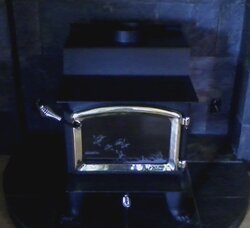
fbelec said: ↑
nice job. that looks like a brand new stove. one question. where is your primary air control now that the door is glass? can you post a picture of your art work on the door?
nice job. that looks like a brand new stove. one question. where is your primary air control now that the door is glass? can you post a picture of your art work on the door?
The stove originally had a glass door in it. Air control is from handle below ash pan. Will post a pic of glass too. Thanks
Ducks in a field on the glass
Attached Files:

photo 2 (2).JPG
Thanks to Coaly for all the info he has given and the advice along the way. Has answered many ? for me as I was clueless to what this stove was and if it was even worth fixing.
Attached Files:

photo 2 (2).JPG
Thanks to Coaly for all the info he has given and the advice along the way. Has answered many ? for me as I was clueless to what this stove was and if it was even worth fixing.
Thanks Coaly, hope this worked what I did. Do you have pics from the one in England? I have the one from Romona CA you sent. You would think there would be more of these out there somewhere or talked about.
Stove looks great. Let us know how well and IF the glass stays clean when you get to using it. Never had any feedback on the operation of this model from anyone!
Haven't found the pic that was sent to me quite a while ago from the UK.
Frank; Here's a bottom view of the air intake on his stove. There was a mobile home installation kit to connect to an outdoor air supply under the mobile home. (Galvanized pipe with "rodent guard" screen supplied in kit by Dura-Vent). There were regular Honey Bears UL listed for conventional homes, and UL listed, HUD approved Honey Bears for use with or without the mobile home kit. To use the mobile approved stove in a conventional home, you simply allow it to use indoor air through the bottom intake.
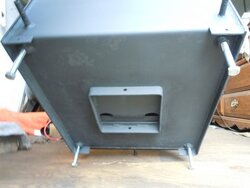
Haven't found the pic that was sent to me quite a while ago from the UK.
Frank; Here's a bottom view of the air intake on his stove. There was a mobile home installation kit to connect to an outdoor air supply under the mobile home. (Galvanized pipe with "rodent guard" screen supplied in kit by Dura-Vent). There were regular Honey Bears UL listed for conventional homes, and UL listed, HUD approved Honey Bears for use with or without the mobile home kit. To use the mobile approved stove in a conventional home, you simply allow it to use indoor air through the bottom intake.

Got the flue pipe installed today and just started the first fire in it. Hopefully all goes well. Took a little while for it to get started but is going good now. The air wash for the door seems to be working good so far and is putting some nice heat off too. Guess the gas company won't like me too much anymore.
Firebrick absorbs moisture from the atmosphere, and new brick is even higher in water content, so after a few fires it will feel like it's putting out more heat without doing anything different.
My first fire in a new Fisher back in 1985 had me wondering if it was going to heat the house that first night. I thought all this work for this little bit of heat ? After the second night it drove us out burning it the same way.
My first fire in a new Fisher back in 1985 had me wondering if it was going to heat the house that first night. I thought all this work for this little bit of heat ? After the second night it drove us out burning it the same way.
Firebrick absorbs moisture from the atmosphere, and new brick is even higher in water content, so after a few fires it will feel like it's putting out more heat without doing anything different.
My first fire in a new Fisher back in 1985 had me wondering if it was going to heat the house that first night. I thought all this work for this little bit of heat ? After the second night it drove us out burning it the same way.
Thanks Coaly for all the good advice. Put off some nice heat throughout the night and still had coals in this morning to get started again. Have to leave the door cracked to get it going good first then it does pretty good. Seems like it doesn't get enough air at first as it comes up in front of the glass and goes up. I guess it was designed this way for the air wash for the glass. It will take a while and some experimenting to see how it performs best. Also seems to burn towards the front too for some reason. Puts out some good heat though. What should the stove temp run as I have double wall all the way and can't check the pipe temps. First level ran around 625 for a long time even after closing the air almost off. I don't believe you can shut the air all the way off either cause it has a notch cut out in it. I think it is like the t88 I believe. You would know more about it than I on the design of it.
Give the chimney, pipe and installation credit for how it burns, it's not just the stove. Good temps, I'm sure it likes the double wall pipe keeping the temps up where it enters the flue.
Yes, it will burn down to ash in the front where there is the most oxygen. Always leave about an inch of ash on the bottom, and remove some from the front each day, then rake the coals forward and reload on it. That's the only time I used the screen. (Goldilocks) Damper wide open and kindling on top of the coals started it right up, and never had to let the coal pile burn down or go out completely to clean ash.
I'd like to know more about the design of it too. I'd imagine the controlled air leak would allow air flow over the glass if closed down fully when too hot, and not allow the air flow to totally stop across glass allowing smoke particles to touch glass.
Yes, it will burn down to ash in the front where there is the most oxygen. Always leave about an inch of ash on the bottom, and remove some from the front each day, then rake the coals forward and reload on it. That's the only time I used the screen. (Goldilocks) Damper wide open and kindling on top of the coals started it right up, and never had to let the coal pile burn down or go out completely to clean ash.
I'd like to know more about the design of it too. I'd imagine the controlled air leak would allow air flow over the glass if closed down fully when too hot, and not allow the air flow to totally stop across glass allowing smoke particles to touch glass.
Give the chimney, pipe and installation credit for how it burns, it's not just the stove. Good temps, I'm sure it likes the double wall pipe keeping the temps up where it enters the flue.
Yes, it will burn down to ash in the front where there is the most oxygen. Always leave about an inch of ash on the bottom, and remove some from the front each day, then rake the coals forward and reload on it. That's the only time I used the screen. (Goldilocks) Damper wide open and kindling on top of the coals started it right up, and never had to let the coal pile burn down or go out completely to clean ash.
I'd like to know more about the design of it too. I'd imagine the controlled air leak would allow air flow over the glass if closed down fully when too hot, and not allow the air flow to totally stop across glass allowing smoke particles to touch glass.
Great point and I agree. May even be designed like the Goldilocks too. Does it look like the one in the above pic too? The air intake shield comes up and turns on a 45 degree towards the glass and has 3 oblong holes about an inch long on the straight piece before the 45 angle. The 45 angle is about a 1/2" up on the glass and sits off about a1/2" too. The smoke shelf seems pretty big too. It sits on a 45 degree too and has about 2 1/2" space where it comes to towards the lower level and is pulled down in the front center a little too. Will take some pics and post soon.
No, Goldilocks only had solid doors with an air intake across the entire front, inside, behind the doors. It has an airspace under the firebox floor with a channel leading from the pedestal to the intake slot. (All air comes up through 4 sided pedestal from below mobile or manufactured home) The air adjustment is a flapper UNDER the air slot that is adjusted by the left draft knob on the door. Turning the knob left, allows the flapper to drop open, same as opening door. (the right knob does not turn and is only on the right side door to make the doors appear the same) The knob is double nutted on a 1/2" threaded bolt that screws in and out of the door, that opens the flapper in the stove . By opening the door, the flapper opens fully.
Notice stud through left door with tab welded on flapper sticking up that adjustable stud length opens flap across stove;
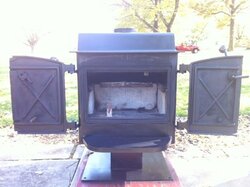
This is the trade marked Bear-O-Matic draft control;
1) Outside air inlet must have same cross sectional area as flue collar.
2) Outside air comes up through pedestal and is preheated in chamber under fire bed.
3) Air regulator provides very precise temperature control utilizing vernier (calibrated) control mechanism.
4) When doors are opened, the air control automatically returns to full open position.
5) When doors are reclosed, the air control "memory" returns the stove to the previous setting.
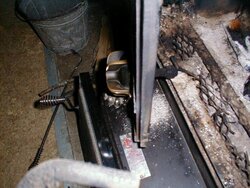
There is also an ash clean out door under the stove to access under the flap and the preheat chamber. Ash from dropping into intake when doors are open accumulates under flap, but doesn't get into air inlet under stove. Many people think this is an air intake of some sort, but it needs to be closed to prevent use of indoor air. There are 2 wing nuts to keep this trap door under the stove front closed.
Page 4 from the manual below shows a cutaway of air intake;
(Installation in a conventional home requires the base to lifted on spacers 1 inch off the floor to allow indoor air into the hollow pedestal)
Notice stud through left door with tab welded on flapper sticking up that adjustable stud length opens flap across stove;

This is the trade marked Bear-O-Matic draft control;
1) Outside air inlet must have same cross sectional area as flue collar.
2) Outside air comes up through pedestal and is preheated in chamber under fire bed.
3) Air regulator provides very precise temperature control utilizing vernier (calibrated) control mechanism.
4) When doors are opened, the air control automatically returns to full open position.
5) When doors are reclosed, the air control "memory" returns the stove to the previous setting.

There is also an ash clean out door under the stove to access under the flap and the preheat chamber. Ash from dropping into intake when doors are open accumulates under flap, but doesn't get into air inlet under stove. Many people think this is an air intake of some sort, but it needs to be closed to prevent use of indoor air. There are 2 wing nuts to keep this trap door under the stove front closed.
Page 4 from the manual below shows a cutaway of air intake;
(Installation in a conventional home requires the base to lifted on spacers 1 inch off the floor to allow indoor air into the hollow pedestal)
Attachments
- Status
- Not open for further replies.
Similar threads
- Replies
- 3
- Views
- 923
- Replies
- 1
- Views
- 831
- Replies
- 5
- Views
- 1K
- Replies
- 1
- Views
- 533


